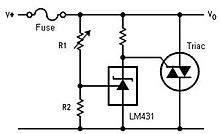Clamp circuit (power supply)
A clamping circuit (crowbar) is an electronic circuit that is used to protect against overvoltage , especially in low voltage DC power supplies. When a certain voltage is reached, the supply voltage is short-circuited with low resistance, so that as a result a fuse can trigger and the power supply is interrupted.
Crowbars are primarily used to protect expensive assemblies whose operating voltage is closely tolerated (e.g. 5-volt supply of digital circuits) against failure of the voltage regulation in the power supply. Due to the relatively long tripping time (around 10 µs), they are not suitable for protecting against overvoltage transients, such as those used in e.g. B. occur by lightning.
The clamping circuit usually has a thyristor or triac as a switching element , which is connected directly to the supply voltage with its two main connections (cathode and anode). When a critical overvoltage level is reached, the thyristor is triggered via the gate by means of a trigger circuit and short-circuits the supply voltage. The short-circuit current that occurs as a result triggers a fuse element, usually a fuse in the supply line, and permanently interrupts the power supply. This fuse must trip fast enough to prevent damage to the thyristor.
The functional difference to an overvoltage protection made of suppressor diodes or varistors is that when the trigger voltage is reached, the supply voltage is short-circuited directly, i.e. the voltage drop and thus the power loss at the thyristor is kept small. Almost all of the power loss then occurs on the fuse, which then trips safely and interrupts the circuit.
In the case of overvoltage protection diodes, on the other hand, there is the problem that long-term overvoltage leads to a high thermal load on the protection diode, with the consequence of thermal failure of the diode. If fuses are used, they must be replaced after they have tripped. Most of the time, however, there is a fault in the power supply, so that it has to be replaced or repaired anyway. Therefore, such clamping circuits are rarely used in conjunction with self-resetting fuses ( PTC fuses ). In PC power supply units, the response of the clamping circuit on the 5 V rail usually does not result in the response of the fuse on the primary side, but the control circuit of the power supply unit detects an overcurrent and thereby reduces the voltage. The power supply remains in this state until it is switched off. After switching on the power supply again, it works again without any problems, but goes back to overcurrent mode if the cause of the trip has not been eliminated. Operating a PC power supply unit without loads can trigger the clamping circuit, as these power supply units are not designed for idle operation.
literature
- Paul Horowitz, Winfield Hill: The Art of Electronics . 2nd Edition. Cambridge University Press, 1998, ISBN 0-521-37095-7 , pp. 317-320 (Chapter 6.06 Overvoltage crowbars ).
